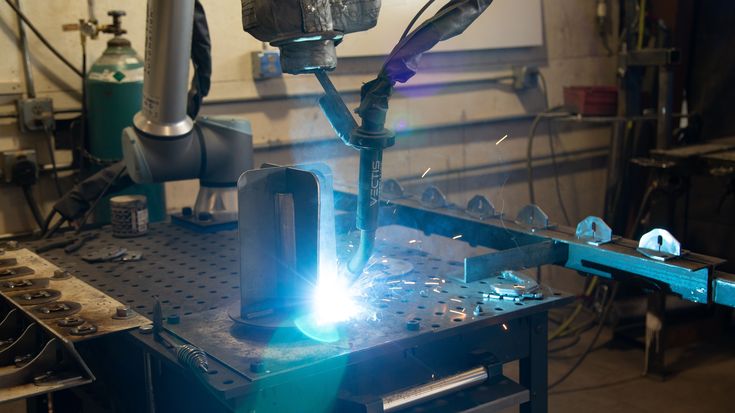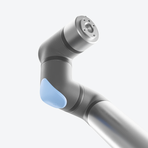Forty years ago, factory automation was all about getting labor out, replacing welders, machine operators and assembly line workers with robots.
Cobot Welding Boosts Fab Shop Productivity
Today that equation is as antiquated as a horse and buggy. Today the focus is on boosting productivity and increasing flexibility on the factory floor to produce more products quicker.
What changed? The labor crisis in manufacturing has had a profound impact on factories large and small, as companies struggle to fill job openings and retain their current employees. Welding is particularly challenged, as the American Welding Society reports 21.4% of welders are 55 and older, and 155,000 are approaching retirement. Coupled with today’s job openings for welders and projected growth in the industry, AWS believes the industry needs to add 360,000 new welders by 2027. And the shortage of skilled welders is a global problem, as the following chart details:
European Labor Authority | In Europe, welders are the 3rd most reported shortage by occupation. |
|---|---|
Manufacturers Monthly | Japan will need 250,000 new welders by 2050 |
India Institute of Welding | India has a current shortage of 1,000,000 welders |
Weld Australia | Australia will need 70,000 new welders by 2030 |
Exploring new welding solutions
Global virtual event | October 26
Unfortunately, most welding jobs are considered DDD applications – Dull, Dirty or Dangerous. These are the toughest positions to fill and have high turnover rates due to low job satisfaction. The US Bureau of Labor Statistics reports a 6.2% turnover rate in manufacturing in 2022 and a 2022 McKinsey report shows that as many as 33% of the European workforce would consider leaving their current jobs. It’s clear the welding labor challenge is not going away.
How Can Cobot Automation Help?
Arc-On Time
The immediate boost to welding productivity comes from amplifying the output of the skilled welders on staff and doing so with modest investments. Cobot welders are commonly deployed in the $75,000 - $85,000 range and go into production is a matter of hours or days. Typical arc-on times for manual welding are 20-30%, as the welder works sequentially to fixture components to be welded, performing the welding, removing the finished weldment, and starting the process over again. A cobot welding system with two sets of fixtures can push the arc-on times to 70% and more, as the welder and the cobot system are now working in parallel. This effectively doubles the productivity of a skilled welder.
To push productivity even higher, larger weldments or smaller parts fixtured in multiples can support a single skilled welder managing two cobot welding systems, each with dual sets of fixturing.
Process Improvements
The speed and precision of a cobot welding system can support weld process improvements that deliver large productivity gains. DeAngelo Marine Exhaust deployed a cobot welding system from Hirebotics and moved from a manual TIG process to an automated MIG process. That process change alone increase the welding rate from 2 inches per minute to 20 inches per minute, and the productivity improvement allowed DeAngelo to pay for the cobot welder on a single order from the US Coast Guard.
Justin Montes, CEO, DeAngelo Marine ExhaustWe went from months to just days turning that order around. With the departmental overtime and everything, that first order paid off my cobot.

Process Enablement
Laser welding is a rapidly emerging technology that offers significant advantages over traditional weld processes. It is 4 to 5 times faster than traditional TIG welding, and according to system integrator Brian Knopp, founder of Cobot Systems, laser welding delivers higher quality and more consistent results. However, full speed laser welding is very difficult for an operator to control manually, which would negate many of the benefits. Cobot Systems has integrated an IPC LightWELD laser with a cobot from Universal Robots and the speed and precision of the system is delivering the productivity and quality benefits that laser welding promises.
Quality, Yield and Reduced Re-work
Even the best manual welders occasionally lose concentration over the course of an 8 or 10 hour shift, and that means quality rejects or time consuming rework. This is particularly common when skilled welders are working on batches of small weldments. Cobot welding systems maintain full process control and precision shift after shift, improving quality and yields, while reducing rework costs.
Mike Gillin, Certified Welder, MT SolarWe’ve built up to 7,500 small parts over a winter. For an operator to sit and do that; you can tell where they’ve gotten sick of it, and some of those parts end up being scrapped. The cobot welder now performs that repetitive work

Reduced Clean Up
Too often manual welding processes are inconsistent, resulting in additional weld passes or excess weld deposition rates. And for parts that require a clean, smooth surface finish, such as Class A automotive parts, that means grinding to remove the excess weld deposition. The precision of cobot welders coupled with the tight control of the welding process minimizes un-needed additional passes and excess weld deposition, and that reduces the time and cost of final grinding and surface finishing.
More on Labor
Hiring in the manufacturing sector is a challenge around the world, as younger generations are not attracted to the traditional view of a factory: Dull, Dirty and Dangerous. And workers who are stuck all day under a weld hood are at high risk of turnover. Cobot automation can help turn those perceptions around, by giving current employees a sense of ownership over the process and advancing their job skills. And prospective employees see the advantages as well. Working with robots, not like robots, is far more attractive than the alternative.
Low risk, rapid deployment cobot welding solutions from Universal Robots and our partners – to get started, go to the machine tending page on the UR website and download our Guide to Cobot Welding.
References
Welding Labor – AWS https://weldingworkforcedata.com/
European Labor – McKinsey https://www.mckinsey.com/capabilities/people-and-organizational-performance/our-insights/european-talent-is-ready-to-walk-out-the-door-how-should-companies-respond
Laser welding - Machine Design https://www.machinedesign.com/markets/robotics/article/21248658/cobot-systems-qa-the-case-for-a-preengineered-laser-welding-cobot-cell

- Universal Robots USA, Inc
- 27175 Haggerty Road, Suite 160
- 48377 Novi, MI